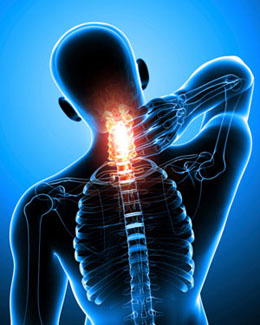Herniated discs can occur in any part of your spine, including neck. This article provides information regarding the same.

The neck is that part of the human body which, along with bearing the weight of the head, experiences a lot of stress due to its constant movement. A herniated disc in the neck is one of the most likely causes of spinal column disorder.
The bones (vertebrae) that form the spine in our back have a cushion of round and flat discs. These discs act as shock absorbers for our spine and give it the required flexibility. When these discs get damaged due to injury or degenerative back pain, they bulge abnormally or rupture (break open). This disc is called a herniated or slipped disc. The seven vertebrae between the head and the chest make up the spine. Slipped disc can occur in any part of the spine; however, it commonly occurs in the neck (cervical) and the lower-back (lumbar) spine.
Symptoms
The symptoms most commonly include neck pain or numbness in the neck. When a nerve in the neck is subjected to pressure, it leads to pain in the muscles between the neck and the shoulder. This pain may shoot down the arm as well. As a result, people may experience weakness in the neck, shoulders, chest, arms, and hands. Tingling sensation or numbness in one arm is another symptom. Weakness in both the arms or legs is a serious problem, and it requires immediate medical attention. People may also experience pain in back of the head. Loss of bladder or bowel control, and burning pain in the shoulders, neck, or arms are some other symptoms.
For the right diagnosis your orthopedic doctor may recommend a simple X-ray, a magnetic resonance imaging (MRI), or CT (computed tomography) scan to confirm which nerve is injured and electromyography to measure the nerve impulse.
Treatment
Most of the time, it is first treated with non-surgical methods which include rest, modified activities, exercises along with muscle relaxers, analgesics, and anti-inflammatory medicines to relieve the pain and inflammation. Your doctor may also recommend physiotherapy or non-surgical spinal decompression, which are amongst the most effective treatments. Cold compresses or ice can also be applied to your neck several times a day; however, it should not be applied for more than 20 minutes at a time. Physical activities should be performed carefully and slowly. You can go for short walks and do exercises as recommended by your doctor. Also, avoid sitting at the same place for long hours.
Also, epidural injections that may lessen nerve irritation and allow more effective participation in physical therapy are recommended. These injections might be given over a period of weeks. In case the symptoms don't improve and you continue to experience weakness and constant pain, then surgery might be considered. Remember, surgery should be considered only in extreme cases.
You must be careful while you indulge in any minor or major physical activities. Also, you must pay attention to your entire body posture while sitting and sleeping in order to get relief from or avoid this problem. You must always seek non-surgical treatment options before you think of surgery as an option to treat it.
Disclaimer:
This Buzzle article is for informative purposes only, and should not be used as a replacement for expert medical advice.


 The neck is that part of the human body which, along with bearing the weight of the head, experiences a lot of stress due to its constant movement. A herniated disc in the neck is one of the most likely causes of spinal column disorder.
The neck is that part of the human body which, along with bearing the weight of the head, experiences a lot of stress due to its constant movement. A herniated disc in the neck is one of the most likely causes of spinal column disorder.